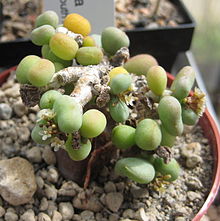Portulacaria pygmaea
| Portulacaria pygmaea | |
|---|---|

| |
| Scientific classification | |
| Kingdom: | Plantae |
| Clade: | Tracheophytes |
| Clade: | Angiosperms |
| Clade: | Eudicots |
| Order: | Caryophyllales |
| Family: | Didiereaceae |
| Genus: | Portulacaria |
| Species: | P. pygmaea
|
| Binomial name | |
| Portulacaria pygmaea Pillans
| |
Portulacaria pygmaea (previously Ceraria pygmaea), also known as the pygmy porkbush, is a small-leaved dwarf succulent plant found on the border between Namibia and the Cape Provinces of South Africa.
Description[edit]
It is a small, compact, soft-wooded, dwarf shrub with Unisexual flowers (dioecious). Its blue-green leaves are semi-evergreen. Its tiny compact branches spread, and often droop, staying close to the ground. It also develops a thick caudex or root-stock, which has led to it being a popular bonsai specimen.
Within the genus Portulacaria it is most closely related to its larger sister-species Portulacaria fruticulosa.[1]
References[edit]
Wikimedia Commons has media related to
Portulacaria pygmaea.
Portulacaria pygmaea.
- ^ P.Bruyns, M.Oliveira-Neto, G.F. Melo de Pinna, C.Klak: Phylogenetic relationships in the Didiereaceae with special reference to subfamily Portulacarioideae. Taxon 63 (5). October 2014. 1053-1064.
